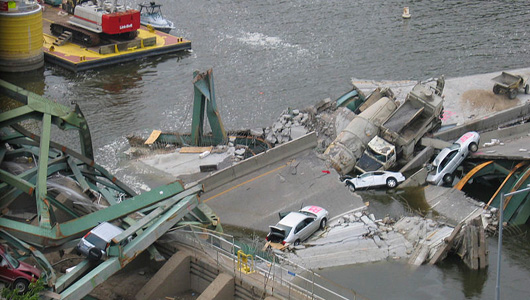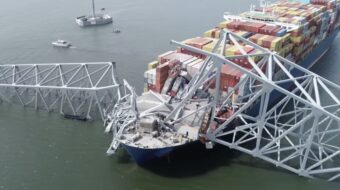
In the presidential campaign, we’ve seen libels on immigrants, fear mongering about Syrian refugees, arguments over Medicare for All and Obamacare, concerns about big money corrupting our politics and more. But too little attention has been paid to the one thing on which there should be consensus within and between the parties: the need to rebuild America now.
We didn’t need the horrors of children at risk from fouled lead pipes in Flint, Michigan to know that our infrastructure is dangerously decrepit. The American Society of Civil Engineers (ASCE) issues a report card every four years on our infrastructure, detailing the level of our investment deficit. According to the most recent report card, issued in 2013, simply to get the country’s drinking water – drinking water – in safe shape would cost more than $1 trillion over the next 25 years.
The report card pegged the immediate cost of fixing at-risk bridges at $76 billion. Add fixing unsafe schools, repairing mass transit, disposing of hazardous waste and maintaining other basics, and ASCE estimated an infrastructure price tag of $3.6 trillion by 2020.
That is simply to repair what is. But we face a far larger investment deficit. If we are ever to enjoy widely shared prosperity, we will need a far more competitive real economy. That means 21st century broadband, fast trains, modernized airports, efficient mass transit and a modernized electric grid, just for starters.
And, as Flint demonstrated, we have communities in distress that need special, targeted investment. Community health clinics to replace hospitals that have closed. New schools with modern facilities and equipment. New water systems. New affordable mass transit that makes getting to jobs in the suburbs possible. Public parks that provide a place for children to play.
And now catastrophic climate change is causing hundreds of billions of dollars in damage. We need significant research and development to generate the next generation of efficient appliances, cars, buildings and factories. We need public/private partnerships, and public investment, to help retrofit buildings and apartment houses for efficiency and alternative energy.
The need is clear. But the price tag should be seen as an opportunity, not a barrier. We still have not recovered from the financial collapse in 2008. Millions have dropped out of the work force. Some 17 million are still in need of full-time work. We pay to imprison too many and educate and employ too few.
In these circumstances, a bold plan to rebuild the country will put people to work, generate demand, and boost a flagging economy. Modernizing our infrastructure would help us compete in the global economy. With interest rates near zero, reputable economists argue that this will pay for itself in increased productivity, employment, wages and tax revenue. If not, we can easily afford it by requiring the wealthy and the corporations to pay their fair share of taxes.
This is not and should not be a partisan question. Republican Abraham Lincoln built the railroads and the land grant colleges even in the midst of the Civil War. Republican Dwight Eisenhower built the interstate highway system in the 1950s. The conservative Chamber of Commerce joins with the AFL-CIO to endorse a major infrastructure plan.
Yet, to date, the presidential candidates haven’t stepped up. Republican talk about infrastructure is focused on Trump’s promise to build a wall on the border and get the Mexicans to pay for it. Marco Rubio promises to spend $1 trillion more – but on the military, not on rebuilding America. Hillary Clinton’s proposal on infrastructure – $275 billion over five years – is below what President Barack Obama has called for. Bernie Sanders proposal – $1 trillion over five years – is still far short of the ASCE accounting.
As Flint has shown, the human costs and risks of allowing our infrastructure to decline are immense. The economic costs are far greater in lost productivity than the price tag of making the investment. Consider this a simple measure of our future. America’s decline will continue for as long as we fail to rebuild the country.
Rev. Jesse Jackson is the founder and president of the Rainbow PUSH Coalition. He was a leader in the civil rights movement alongside Dr. Martin Luther King, Jr. and was twice a candidate for President of the United States.
This article originally appeared in the Chicago Sun-Times. It is reprinted here with the permission of Rainbow PUSH.
Photo: Wikipedia (CC)









